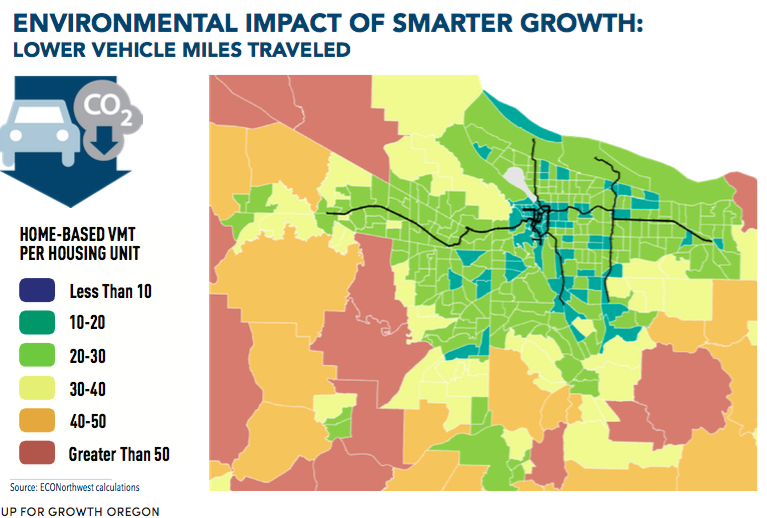Building a city so its residents don’t have to drive so much powers economic growth
A decade ago, we coined the term “green dividend.” We noted that among large US metropolitan areas, Portland residents drove significantly fewer miles per person each day, thanks to the city’s compact development pattern, strong economic integration, good transit system, and high levels of cycling. In 2007, we estimated that compared to the typical urban American, Portlander’s saved more than a billion dollars a year in the cost of fuel and vehicles because they drove about 20 percent less than the US average.
The existence of this billion dollar green dividend is invariably overlooked in superficial comparisons of living costs and housing affordability. Because Portlanders have a billion dollars more disposable income annually that they’re not spending on cars and gasoline, they have more to spend on other things they value, like rent and beer. Perhaps it’s not a coincidence that the Portland metro area has more restaurants per capita than all but two of the nation’s largest metro areas.
Recently, we ran across two new facts that buttress the case for the green dividend. The first comes from the Bureau of Economic Analysis state-level estimates of consumer expenditures. This series estimates how much households spend on a variety of items. It breaks down expenditures by state, rather than metropolitan area. Portland is about 40 percent of Oregon’s population, and drives less per capita than the rest of the state, so the figures cited here probably understate the Green Dividend.
Oregon and US household spending on vehicles and gasoline, Five-year average (2011-2016).
Source: BEA, Consumer Expenditure Survey
Over the past five years, the typical Oregon household spent about 16 percent less on motor vehicles and parts and about 15 percent less on gasoline and other energy than the typical America. (These are the two expenditure categories that most closely align with automobile expenditures). And the difference isn’t because Oregonians have less income to spend: per household spending in Oregon is almost exactly equal to the national average (less than a tenth of a percent difference), which means that the difference in spending is due to different choices, rather than lower incomes. Over the past five years, the typical Oregon family has spent about $390 per year less on owning and operating automobiles than the typical American household, a green dividend that helps stimulate the Oregon economy.
The second item is forward-looking. What if a city like Portland were to take the Green Dividend thinking seriously, and build new housing in a denser pattern? A new study prepared for Up for Growth (a housing advocacy group) by ECONorthwest looks at various scenarios for future development in the Portland metropolitan area. It considers the relative economic, social and environmental effects of adding housing units in a sprawling suburban development pattern, or a denser, more urban smart growth pattern. The report compares what would happen to the Portland area over the next two decades, depending on whether it chooses a “more of the same scenario” in which 70 percent of new housing is single family developments or a “smart growth scenario” in which 90 percent of new housing is in higher density, walkable, transit served multi-family housing.
One of the study’s key findings is that denser urban neighborhoods generate far fewer vehicle miles of travel (VMT) per resident than do more remote, lower density suburban neighborhoods. This map of Portland shows that central, transit connected neighborhoods have far lower VMT than more peripheral locations. (The black lines on the map show the location of Portland’s light rail and streetcar network).
In the scenario where more development is concentrated in denser neighborhoods, vehicle miles of travel falls appreciably. The report concludes
By locating housing in areas with low VMT, the Smart Growth scenario results in 1.5 million fewer miles travelled daily for commuters compared to the More of the Same scenario
While this is impressive in its own right, its worth considering the monetary value of this avoided travel. Our rule of thumb for computing car travel costs is roughly 50 cents per mile. Reducing travel by 1.5 million miles per day saves Portland area residents $187 million annually in the costs of fuel and vehicle costs. (The calculation is 1.5 million miles per commuting day multiplied by 250 commuting days, multiplied by 50 cents per mile). This money then is available to households to spend on other things that they value.
The cost savings are just the beginning of course. Less driving also means less dying; when we drive fewer miles there are fewer crashes, fewer injuries and fewer deaths.
Owning and operating cars is expensive. Building cities where people don’t have to rely so much on private cars for every trip and can generally travel shorter distances to reach common destinations saves households money. This green dividend is a powerful argument for investing in great urban neighborhoods and the infrastructure that supports them.



